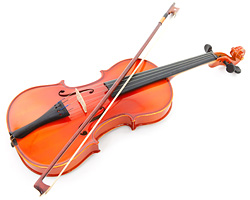21 Tips to Take Good Care of your Violin : Violin Care 101

21 Jul 2016
Violins can last for hundreds of years, but that is only with good care. Maintaining your instrument can help maintain its tone, stability, and ultimately its market value.
Sometimes we are not taught important information about our instrument, we forget some very important things, or we get lazy with taking care of our violin. Here are 21 expert tips to take better care of your instrument and bow to keep them in good repair.
1. Put it away
Always put your violin away when you are not playing. Never leave it on a chair or table, or even hanging from your music stand. When your violin is not in its case, it can be easily knocked over, sat on, or stepped upon.
2. Keep your case in a safe place
It is not enough just to put your violin in its case; you must also store your case properly. Don’t store your case where your violin can get wet or be tipped over. Always store your case face-up, or on its side.
Never let your violin rest on its bridge, even when it’s in its case; the added pressure combined with the high tension of the strings can cause the wood to crack.
3. Make sure your case is of good quality
Your violin case should be able to strap your violin down by the neck so that it will be secure while in transit. Make sure that your case has a lot of padding to cushion the violin, but will not rub aggressively against the varnish.
4. Make sure your case is suited for your climate
Do you live somewhere with a harsh winter? Do you live in a dry climate? Make sure your case has features to deal with these issues, like insulation and a built-in humidifier.
5. Always clean your violin after playing
The varnish on your violin is made out of rosin, so any rosin left over on the body of your violin can cling to the instrument and become dirty. This will ruin the finish of your instrument, and you will eventually have to get it re-varnished if you do not clean it properly.
Use a soft, lint-free cloth to clean your violin. Many violin stores sell inexpensive cloths that are ideal for cleaning your violin.
6. Clean the stick of your bow too
The wood of your bow is also treated with the same varnish as your violin, so remember to clean the rosin off of the stick after each time you play. (Do not clean off the hair of the bow, however).
7. Never use alcohol or other solvents
Never use alcohol or other solvents to clean your instrument; they can strip your violin of its varnish. Even hot water can hurt your violin.
If you are consistent enough, you do not need to use anything by a dry soft cloth, but if you need something more, purchase a violin-specific polish (NEVER furniture polish). Use a separate cloth than your usual cleaning cloth to polish your instrument.
8. Use a humidifier in the winter
Your violin and bow are made out of organic materials. If the wood dries out too much during the winter, even though it is treated and varnished, it can crack.
Humidifiers like the Dampit can be placed right inside your instrument. Other humidifiers rest in your case. Sometimes high-quality violin cases have built-in humidifiers.
9. Sticky pegs
Do your pegs stick, making it hard to tune your violin? You can apply a little bit (not a lot!) of what is called “peg dope” onto the part of the peg that is in contact with the violin. This will allow for the pegs to move more freely.
10. Slipping pegs
Alternatively, do your pegs slip when you try to tune your violin? Then it’s time for a check-up! Take your violin into a luthier to get your pegs fitted properly.
11. Buzzing when you play
Often, if your chin rest is touching the tailpiece of your violin, it will cause an annoying buzzing noise. Use a chin rest key to tighten, make sure that you do not insert it into the hole too far, or it will scratch the violin on the other side.
12. Avoid touching the varnish
Your fingers have oils that can react and strip the varnish off of your instrument. Try to touch the violin only by the neck and chinrest.
13. Don’t touch the hair of your bow with your fingers
Do you notice that the hair of your bow is dirty near the frog? This is the dirt from your fingers. To keep the hair supple and clean, avoid touching the hair with your hands.
14. Support the neck while tuning
When you are tuning your violin with your pegs, support the other side of the neck with your other hand. If you do not do this, you run the risk of snapping your neck, or loosening the seams around it.
15. Get your bow rehaired
This depends on how much you practice, but most people who play 2–4 hours a day at least get their bow rehaired twice a year. If you are missing a lot of hair, you should consider getting your bow rehaired so that your bow does not warp.
16. Always loosen your bow when not in use
If you do not loosen your bow after you play, the tension can cause the stick to warp over time. Also, do not over-tighten your bow; only tighten your bow as much as the width of the stick. Too tight, and your bow can break.
17. Changing violin strings
Only change violin strings one at a time to maintain the tension over the bridge. If you do not do this, the bridge and the sound post may fall over. Pay close attention to the look of your strings; if they are frayed there is a greater chance that they might break.
18. Bridge is leaning forward
Is your bridge starting to lean forward? If so you will have to carefully adjust it so that the feet are flat against the face of the violin. The bridge will start to lean forward from the tension of the strings.
If it leans too much, it is at risk of falling. If the bridge falls it can cause the sound post inside the instrument to fall as well. Another tip: loosen your strings slightly before you move your bridge.
19. Sound post
If you cannot produce very much sound or the tone is impaired, check to see if your sound post is in the correct position or has fallen down.
In the case that it has fallen down (you’ll hear it rattling about), take your violin to a luthier and he or she will reset the post and place it in the correct position with a Sound Post Setter.
20. Never use glue on your instrument
Violins are made out of special, weak animal hide glue. This glue allows for the instrument to breathe properly during different seasons. The strength of the glue is a feature and not a bug because it allows for easy repair.
Never use glue that you can purchase or make yourself on your instrument. Go to a luthier if you think that your violin has split a seam (you can check for this by running a fingernail around the seams of your violin, if it makes a hollow sound when you hit a certain section, your seam might be split).
21. Take your violin in to a luthier
Just like you take yourself or your family in to the doctor for a check-up, you should take your instrument into a violin maker or luthier to be cleaned and maintained. Don’t ignore minor problems; many major problems like cracks can start out very small.
Moreover, especially if you are a beginner, you will often not have the expertise or know-how to take care of problems with your violin. Also, there are many specialised tools that you cannot access yourself.As a general rule, if you are unsure of something with your instrument, consult an expert to avoid making mistakes and damaging your violin and bow.
This article was republished with permission. Find the original article, written by Austin here
Also checkout their website
